TOYOTA AURIS 2018 Owners Manual (in English)
Manufacturer: TOYOTA, Model Year: 2018, Model line: AURIS, Model: TOYOTA AURIS 2018Pages: 592, PDF Size: 28.6 MB
Page 301 of 592
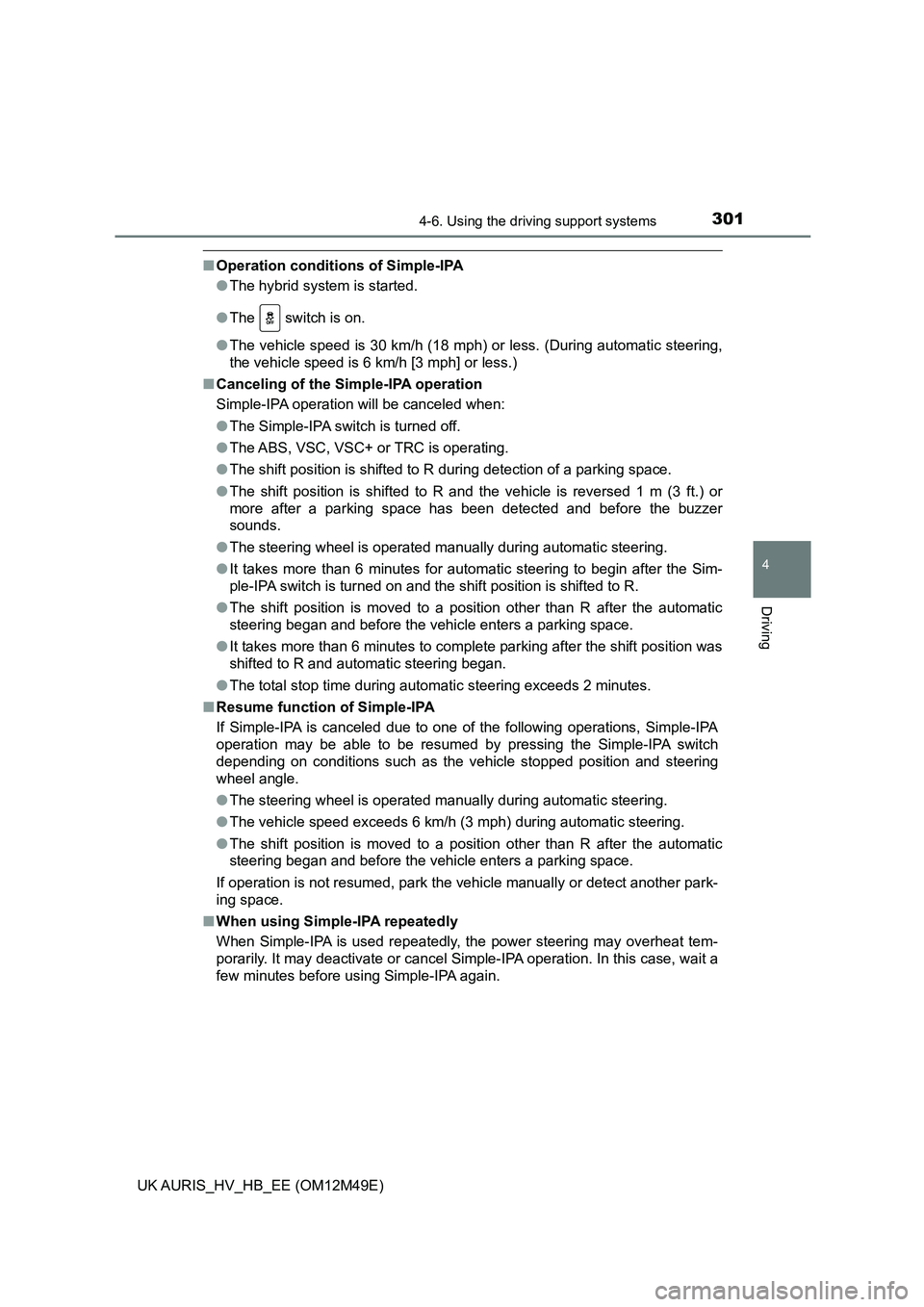
3014-6. Using the driving support systems
UK AURIS_HV_HB_EE (OM12M49E)
4
Driving
■Operation conditions of Simple-IPA
● The hybrid system is started.
● The switch is on.
● The vehicle speed is 30 km/h (18 mph) or less. (During automatic steering,
the vehicle speed is 6 km/h [3 mph] or less.)
■ Canceling of the Simple-IPA operation
Simple-IPA operation will be canceled when:
● The Simple-IPA switch is turned off.
● The ABS, VSC, VSC+ or TRC is operating.
● The shift position is shifted to R during detection of a parking space.
● The shift position is shifted to R and the vehicle is reversed 1 m (3 ft.) or
more after a parking space has been detected and before the buzzer
sounds.
● The steering wheel is operated manually during automatic steering.
● It takes more than 6 minutes for automatic steering to begin after the Sim-
ple-IPA switch is turned on and the shift position is shifted to R.
● The shift position is moved to a position other than R after the automatic
steering began and before the vehicle enters a parking space.
● It takes more than 6 minutes to complete parking after the shift position was
shifted to R and automatic steering began.
● The total stop time during automatic steering exceeds 2 minutes.
■ Resume function of Simple-IPA
If Simple-IPA is canceled due to one of the following operations, Simple-IPA
operation may be able to be resumed by pressing the Simple-IPA switch
depending on conditions such as the vehicle stopped position and steering
wheel angle.
● The steering wheel is operated manually during automatic steering.
● The vehicle speed exceeds 6 km/h (3 mph) during automatic steering.
● The shift position is moved to a position other than R after the automatic
steering began and before the vehicle enters a parking space.
If operation is not resumed, park the vehicle manually or detect another park-
ing space.
■ When using Simple-IPA repeatedly
When Simple-IPA is used repeatedly, the power steering may overheat tem-
porarily. It may deactivate or cancel Simple-IPA operation. In this case, wait a
few minutes before using Simple-IPA again.
Page 302 of 592
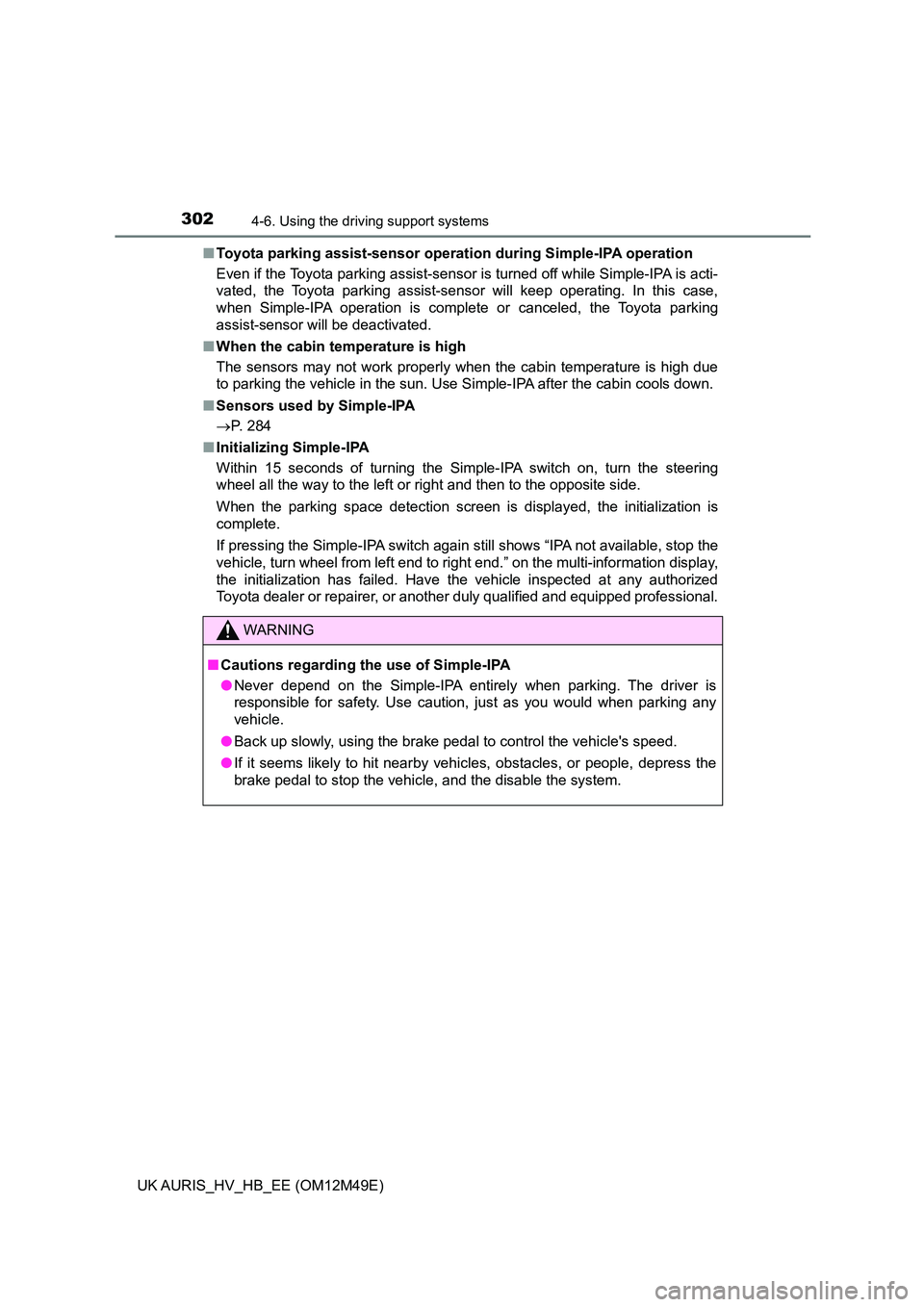
3024-6. Using the driving support systems
UK AURIS_HV_HB_EE (OM12M49E)
■ Toyota parking assist-sensor operation during Simple-IPA operation
Even if the Toyota parking assist-sensor is turned off while Simple-IPA is acti-
vated, the Toyota parking assist-sensor will keep operating. In this case,
when Simple-IPA operation is complete or canceled, the Toyota parking
assist-sensor will be deactivated.
■ When the cabin temperature is high
The sensors may not work properly when the cabin temperature is high due
to parking the vehicle in the sun. Use Simple-IPA after the cabin cools down.
■ Sensors used by Simple-IPA
P. 284
■ Initializing Simple-IPA
Within 15 seconds of turning the Simple-IPA switch on, turn the steering
wheel all the way to the left or right and then to the opposite side.
When the parking space detection screen is displayed, the initialization is
complete.
If pressing the Simple-IPA switch again still shows “IPA not available, stop the
vehicle, turn wheel from left end to ri ght end.” on the multi-information display,
the initialization has failed. Have the vehicle inspected at any authorized
Toyota dealer or repairer, or another duly qualified and equipped professional.
WARNING
■ Cautions regarding the use of Simple-IPA
● Never depend on the Simple-IPA entirely when parking. The driver is
responsible for safety. Use caution, just as you would when parking any
vehicle.
● Back up slowly, using the brake pedal to control the vehicle's speed.
● If it seems likely to hit nearby vehicles, obstacles, or people, depress the
brake pedal to stop the vehicle, and the disable the system.
Page 303 of 592
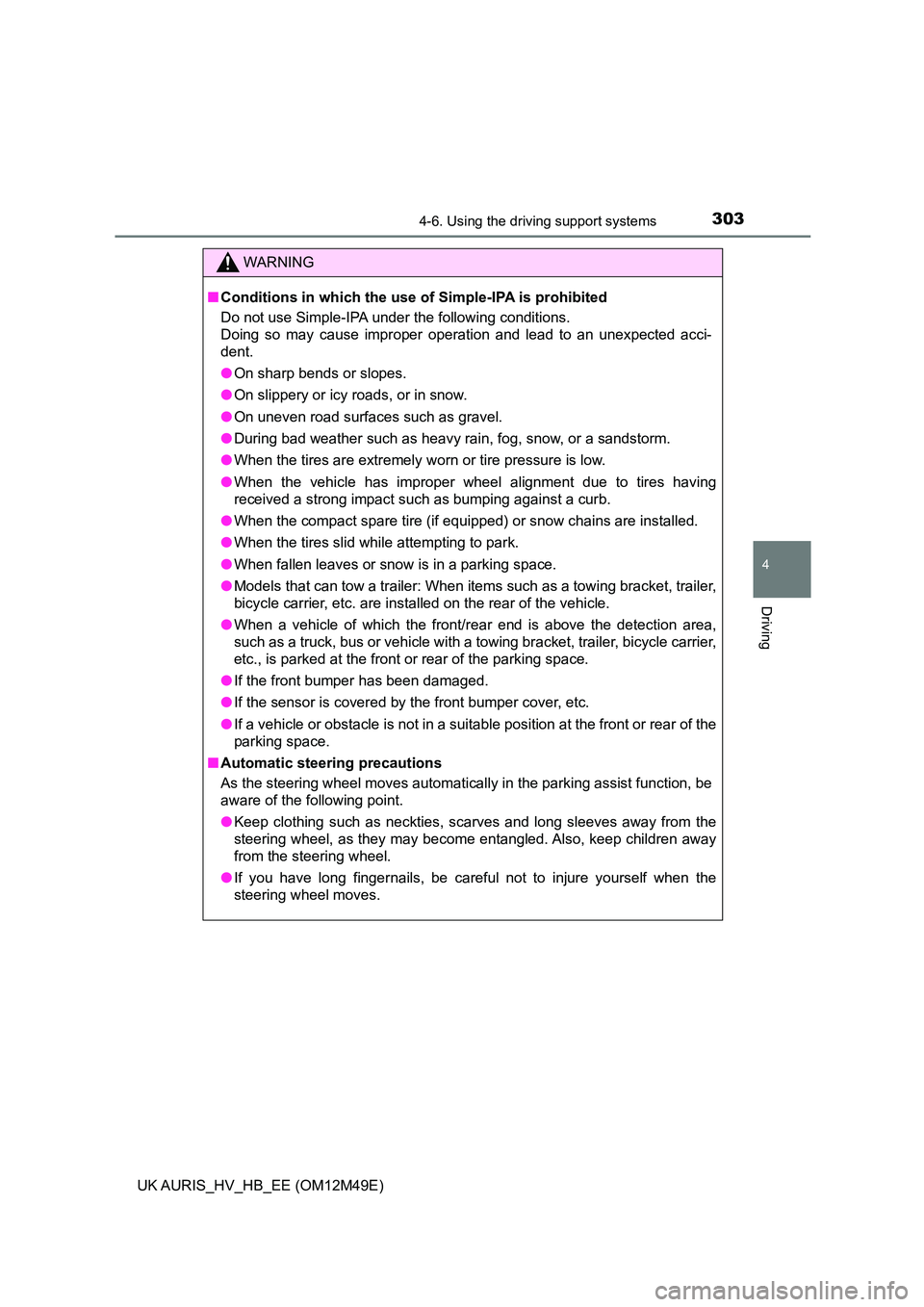
3034-6. Using the driving support systems
UK AURIS_HV_HB_EE (OM12M49E)
4
Driving
WARNING
■Conditions in which the use of Simple-IPA is prohibited
Do not use Simple-IPA under the following conditions.
Doing so may cause improper operation and lead to an unexpected acci-
dent.
● On sharp bends or slopes.
● On slippery or icy roads, or in snow.
● On uneven road surfaces such as gravel.
● During bad weather such as heavy rain, fog, snow, or a sandstorm.
● When the tires are extremely worn or tire pressure is low.
● When the vehicle has improper wheel alignment due to tires having
received a strong impact such as bumping against a curb.
● When the compact spare tire (if equipped) or snow chains are installed.
● When the tires slid while attempting to park.
● When fallen leaves or snow is in a parking space.
● Models that can tow a trailer: When items such as a towing bracket, trailer,
bicycle carrier, etc. are installed on the rear of the vehicle.
● When a vehicle of which the front/rear end is above the detection area,
such as a truck, bus or vehicle with a towing bracket, trailer, bicycle carrier,
etc., is parked at the front or rear of the parking space.
● If the front bumper has been damaged.
● If the sensor is covered by the front bumper cover, etc.
● If a vehicle or obstacle is not in a suitable position at the front or rear of the
parking space.
■ Automatic steering precautions
As the steering wheel moves automatically in the parking assist function, be
aware of the following point.
● Keep clothing such as neckties, scarves and long sleeves away from the
steering wheel, as they may become entangled. Also, keep children away
from the steering wheel.
● If you have long fingernails, be careful not to injure yourself when the
steering wheel moves.
Page 304 of 592
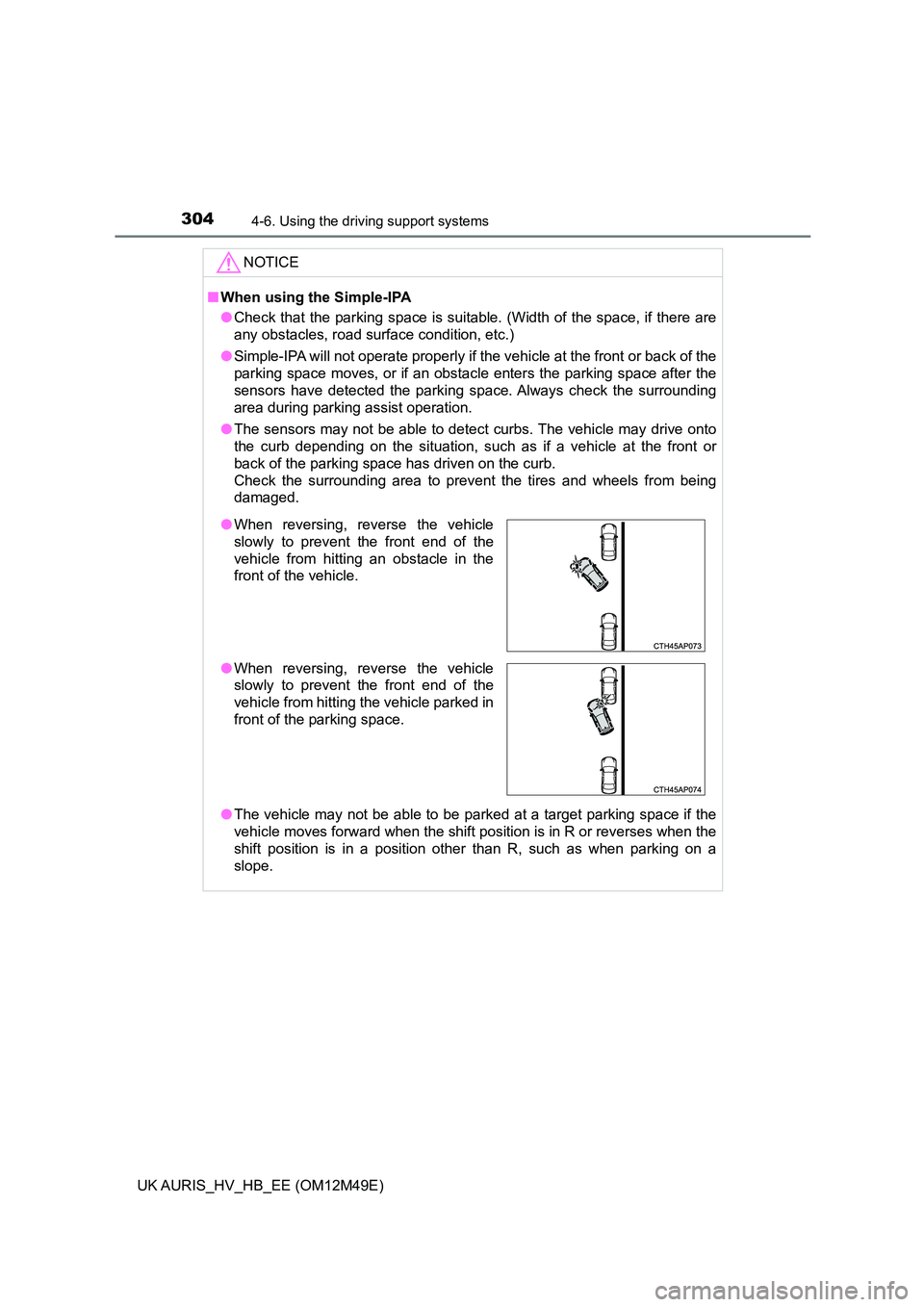
3044-6. Using the driving support systems
UK AURIS_HV_HB_EE (OM12M49E)
NOTICE
■When using the Simple-IPA
● Check that the parking space is suitable. (Width of the space, if there are
any obstacles, road surface condition, etc.)
● Simple-IPA will not operate properly if the vehicle at the front or back of the
parking space moves, or if an obstacle enters the parking space after the
sensors have detected the parking space. Always check the surrounding
area during parking assist operation.
● The sensors may not be able to detect curbs. The vehicle may drive onto
the curb depending on the situation, such as if a vehicle at the front or
back of the parking space has driven on the curb.
Check the surrounding area to prevent the tires and wheels from being
damaged.
● The vehicle may not be able to be parked at a target parking space if the
vehicle moves forward when the shift position is in R or reverses when the
shift position is in a position other than R, such as when parking on a
slope.
● When reversing, reverse the vehicle
slowly to prevent the front end of the
vehicle from hitting an obstacle in the
front of the vehicle.
● When reversing, reverse the vehicle
slowly to prevent the front end of the
vehicle from hitting the vehicle parked in
front of the parking space.
Page 305 of 592
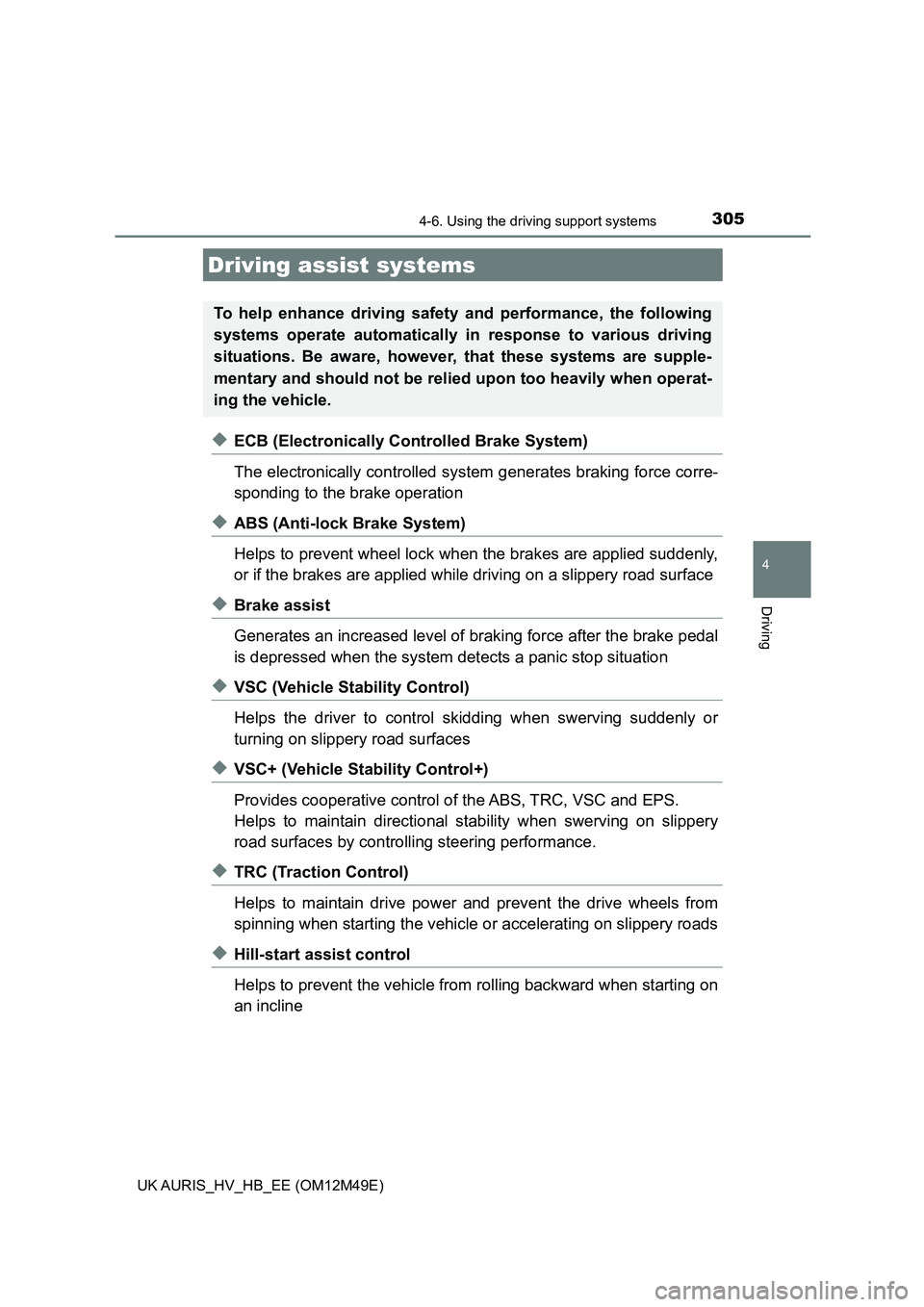
3054-6. Using the driving support systems
UK AURIS_HV_HB_EE (OM12M49E)
4
Driving
◆ECB (Electronically Controlled Brake System)
The electronically controlled system generates braking force corre-
sponding to the brake operation
◆ABS (Anti-lock Brake System)
Helps to prevent wheel lock when the brakes are applied suddenly,
or if the brakes are applied while driving on a slippery road surface
◆Brake assist
Generates an increased level of braking force after the brake pedal
is depressed when the system detects a panic stop situation
◆VSC (Vehicle Stability Control)
Helps the driver to control skidding when swerving suddenly or
turning on slippery road surfaces
◆VSC+ (Vehicle Stability Control+)
Provides cooperative control of the ABS, TRC, VSC and EPS.
Helps to maintain directional stability when swerving on slippery
road surfaces by controllin g steering performance.
◆TRC (Traction Control)
Helps to maintain drive power and prevent the drive wheels from
spinning when starting the vehicle or accelerating on slippery roads
◆Hill-start assist control
Helps to prevent the vehicle from rolling backward when starting on
an incline
Driving assist systems
To help enhance driving safety and performance, the following
systems operate automatically in response to various driving
situations. Be aware, however, that these systems are supple-
mentary and should not be relied upon too heavily when operat-
ing the vehicle.
Page 306 of 592
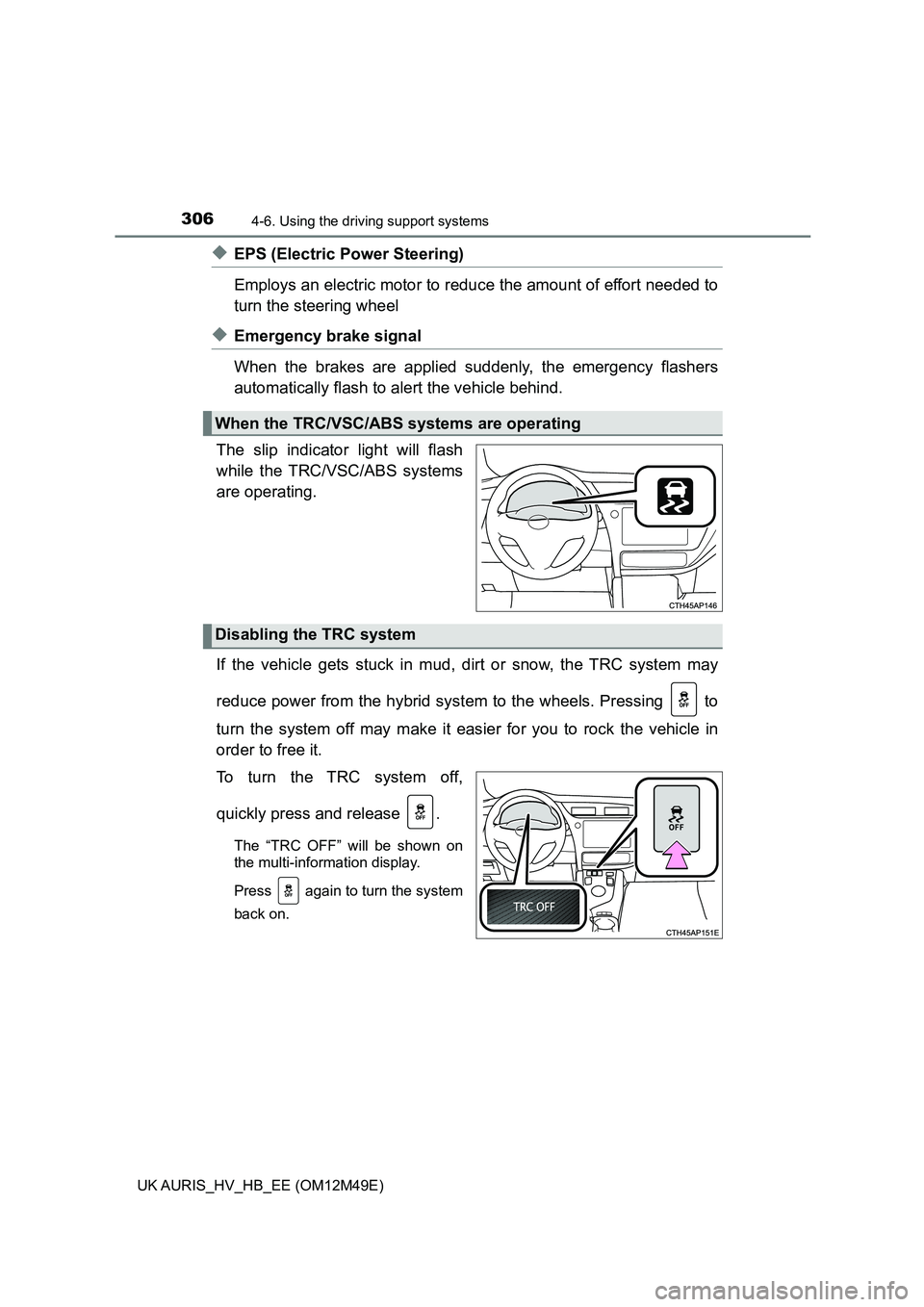
3064-6. Using the driving support systems
UK AURIS_HV_HB_EE (OM12M49E)
◆EPS (Electric Power Steering)
Employs an electric motor to redu ce the amount of effort needed to
turn the steering wheel
◆Emergency brake signal
When the brakes are applied su ddenly, the emergency flashers
automatically flash to alert the vehicle behind.
The slip indicator light will flash
while the TRC/ VSC/ABS systems
are operating.
If the vehicle gets stuck in mud, dirt or snow, the TRC system may
reduce power from the hybrid syst em to the wheels. Pressing to
turn the system off may make it eas ier for you to rock the vehicle in
order to free it.
To turn the TRC system off,
quickly press and release .
The “TRC OFF” will be shown on
the multi-information display.
Press again to turn the system
back on.
When the TRC/VSC/ABS systems are operating
Disabling the TRC system
Page 307 of 592
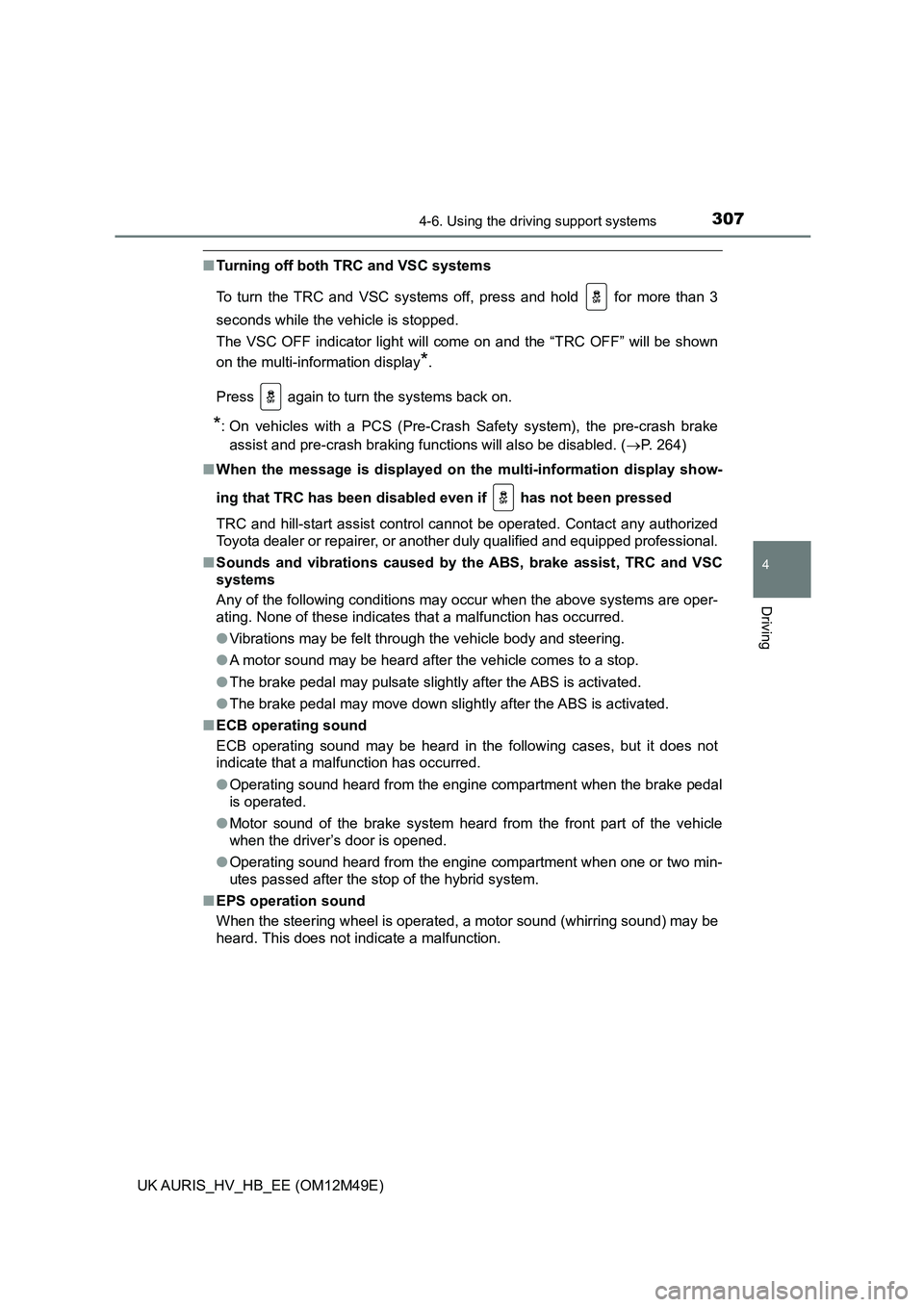
3074-6. Using the driving support systems
UK AURIS_HV_HB_EE (OM12M49E)
4
Driving
■Turning off both TRC and VSC systems
To turn the TRC and VSC systems off, press and hold for more than 3
seconds while the vehicle is stopped.
The VSC OFF indicator light will come on and the “TRC OFF” will be shown
on the multi-information display*.
Press again to turn the systems back on.
*: On vehicles with a PCS (Pre-Crash Safety system), the pre-crash brake
assist and pre-crash braking functions will also be disabled. ( P. 264)
■ When the message is displayed on the multi-information display show-
ing that TRC has been disabled even if has not been pressed
TRC and hill-start assist control cannot be operated. Contact any authorized
Toyota dealer or repairer, or another duly qualified and equipped professional.
■ Sounds and vibrations caused by the ABS, brake assist, TRC and VSC
systems
Any of the following conditions may occur when the above systems are oper-
ating. None of these indicates that a malfunction has occurred.
● Vibrations may be felt through the vehicle body and steering.
● A motor sound may be heard after the vehicle comes to a stop.
● The brake pedal may pulsate slightly after the ABS is activated.
● The brake pedal may move down slightly after the ABS is activated.
■ ECB operating sound
ECB operating sound may be heard in the following cases, but it does not
indicate that a malfunction has occurred.
● Operating sound heard from the engine compartment when the brake pedal
is operated.
● Motor sound of the brake system heard from the front part of the vehicle
when the driver’s door is opened.
● Operating sound heard from the engine compartment when one or two min-
utes passed after the stop of the hybrid system.
■ EPS operation sound
When the steering wheel is operated, a motor sound (whirring sound) may be
heard. This does not indicate a malfunction.
Page 308 of 592
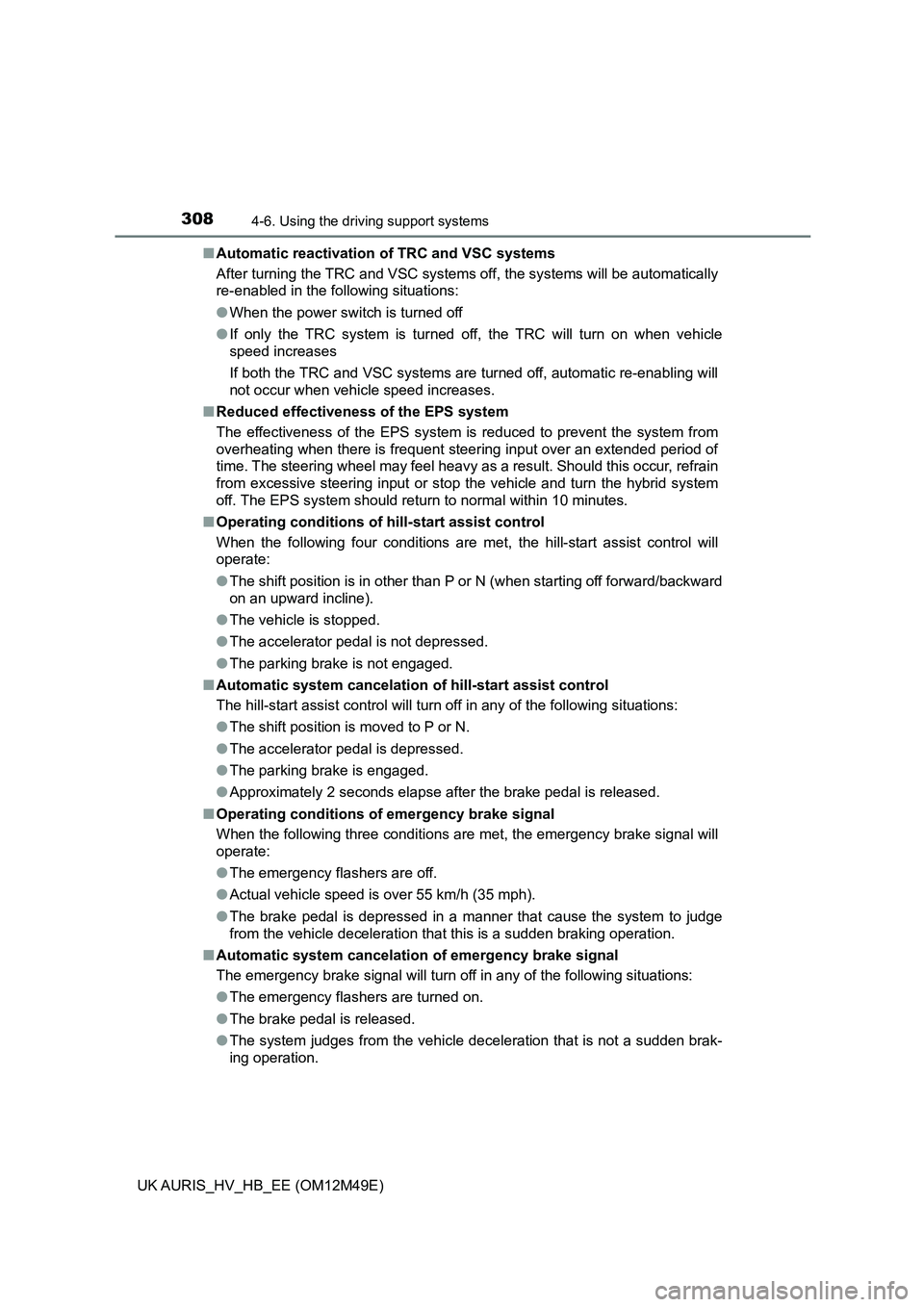
3084-6. Using the driving support systems
UK AURIS_HV_HB_EE (OM12M49E)
■ Automatic reactivation of TRC and VSC systems
After turning the TRC and VSC systems off, the systems will be automatically
re-enabled in the following situations:
● When the power switch is turned off
● If only the TRC system is turned off, the TRC will turn on when vehicle
speed increases
If both the TRC and VSC systems are turned off, automatic re-enabling will
not occur when vehicle speed increases.
■ Reduced effectiveness of the EPS system
The effectiveness of the EPS system is reduced to prevent the system from
overheating when there is frequent steering input over an extended period of
time. The steering wheel may feel heavy as a result. Should this occur, refrain
from excessive steering input or stop the vehicle and turn the hybrid system
off. The EPS system should return to normal within 10 minutes.
■ Operating conditions of hill-start assist control
When the following four conditions are met, the hill-start assist control will
operate:
● The shift position is in other than P or N (when starting off forward/backward
on an upward incline).
● The vehicle is stopped.
● The accelerator pedal is not depressed.
● The parking brake is not engaged.
■ Automatic system cancelation of hill-start assist control
The hill-start assist control will turn off in any of the following situations:
● The shift position is moved to P or N.
● The accelerator pedal is depressed.
● The parking brake is engaged.
● Approximately 2 seconds elapse after the brake pedal is released.
■ Operating conditions of emergency brake signal
When the following three conditions are met, the emergency brake signal will
operate:
● The emergency flashers are off.
● Actual vehicle speed is over 55 km/h (35 mph).
● The brake pedal is depressed in a manner that cause the system to judge
from the vehicle deceleration that this is a sudden braking operation.
■ Automatic system cancelation of emergency brake signal
The emergency brake signal will turn off in any of the following situations:
● The emergency flashers are turned on.
● The brake pedal is released.
● The system judges from the vehicle deceleration that is not a sudden brak-
ing operation.
Page 309 of 592
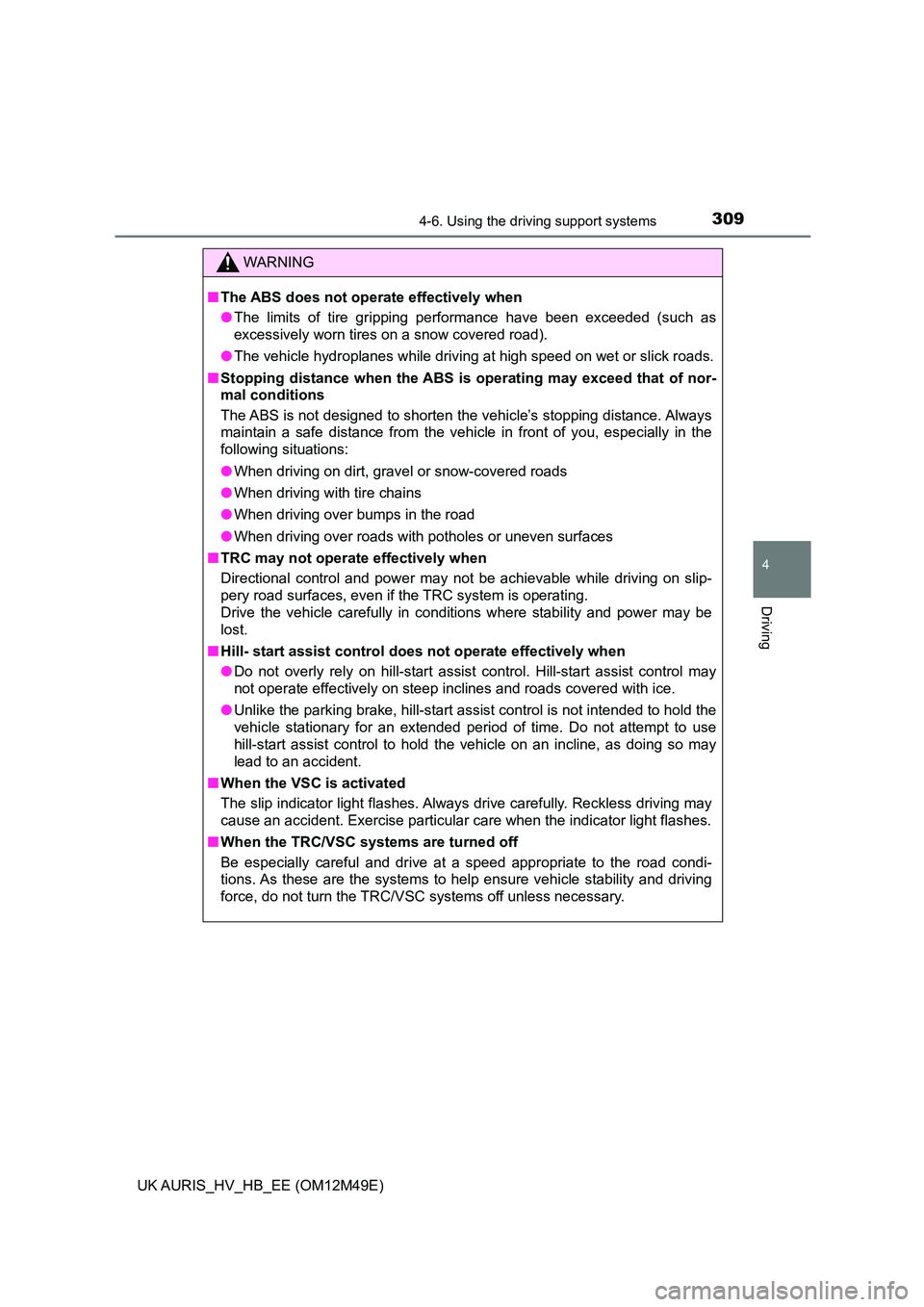
3094-6. Using the driving support systems
UK AURIS_HV_HB_EE (OM12M49E)
4
Driving
WARNING
■The ABS does not operate effectively when
● The limits of tire gripping performance have been exceeded (such as
excessively worn tires on a snow covered road).
● The vehicle hydroplanes while driving at high speed on wet or slick roads.
■ Stopping distance when the ABS is operating may exceed that of nor-
mal conditions
The ABS is not designed to shorten the vehicle’s stopping distance. Always
maintain a safe distance from the vehicle in front of you, especially in the
following situations:
● When driving on dirt, gravel or snow-covered roads
● When driving with tire chains
● When driving over bumps in the road
● When driving over roads with potholes or uneven surfaces
■ TRC may not operate effectively when
Directional control and power may not be achievable while driving on slip-
pery road surfaces, even if the TRC system is operating.
Drive the vehicle carefully in conditions where stability and power may be
lost.
■ Hill- start assist control does not operate effectively when
● Do not overly rely on hill-start assist control. Hill-start assist control may
not operate effectively on steep inclines and roads covered with ice.
● Unlike the parking brake, hill-start assist control is not intended to hold the
vehicle stationary for an extended period of time. Do not attempt to use
hill-start assist control to hold the vehicle on an incline, as doing so may
lead to an accident.
■ When the VSC is activated
The slip indicator light flashes. Always drive carefully. Reckless driving may
cause an accident. Exercise particular care when the indicator light flashes.
■ When the TRC/VSC systems are turned off
Be especially careful and drive at a speed appropriate to the road condi-
tions. As these are the systems to help ensure vehicle stability and driving
force, do not turn the TRC/VSC systems off unless necessary.
Page 310 of 592
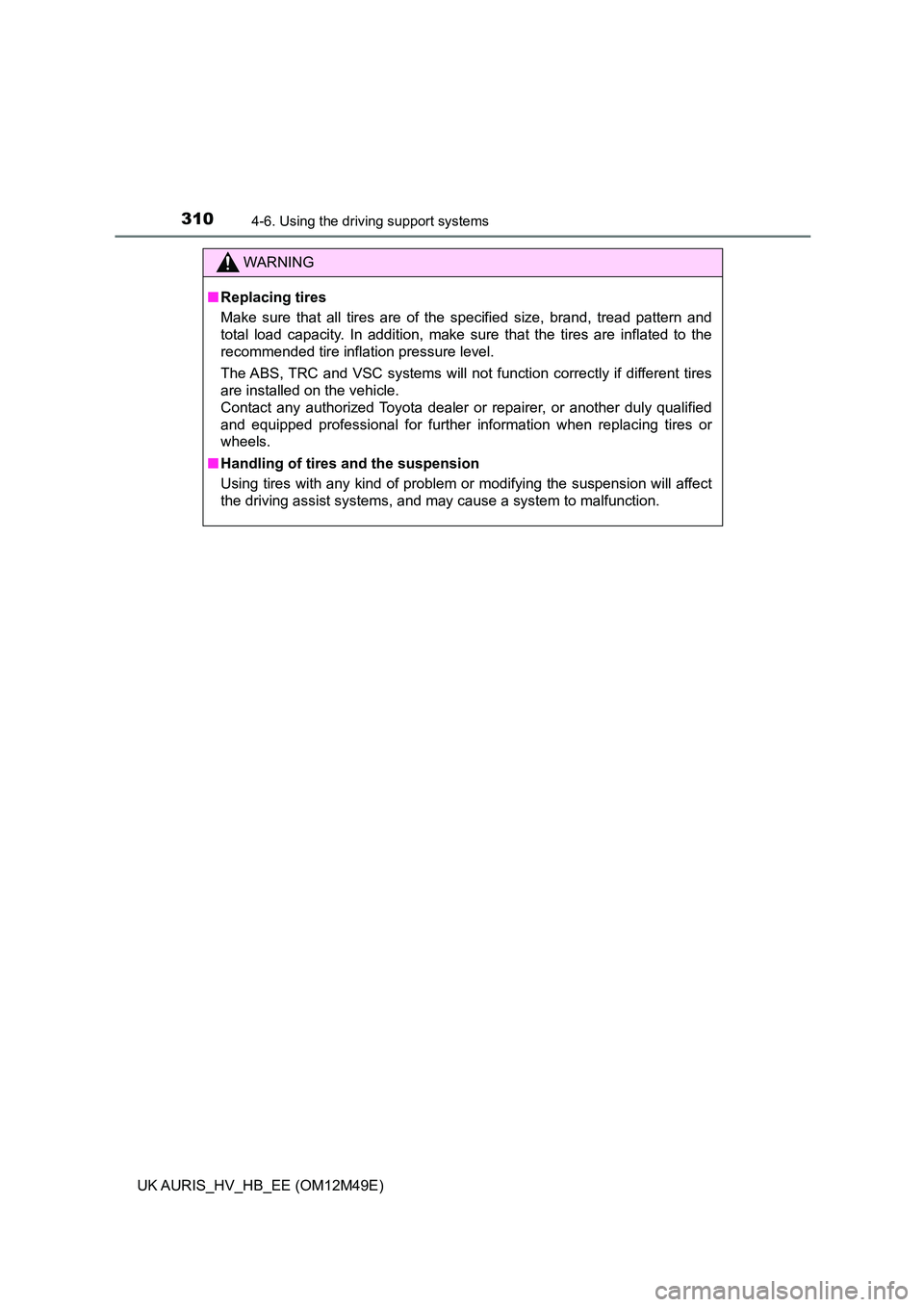
3104-6. Using the driving support systems
UK AURIS_HV_HB_EE (OM12M49E)
WARNING
■Replacing tires
Make sure that all tires are of the specified size, brand, tread pattern and
total load capacity. In addition, make sure that the tires are inflated to the
recommended tire inflation pressure level.
The ABS, TRC and VSC systems will not function correctly if different tires
are installed on the vehicle.
Contact any authorized Toyota dealer or repairer, or another duly qualified
and equipped professional for further information when replacing tires or
wheels.
■ Handling of tires and the suspension
Using tires with any kind of problem or modifying the suspension will affect
the driving assist systems, and may cause a system to malfunction.